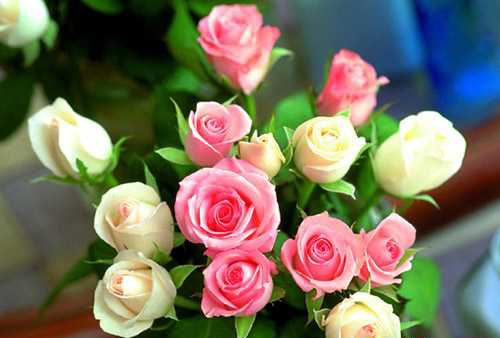What should I do if I get red spots?
When the temperature is high, the humidity is high, and the ventilation is poor, the leaves of Zhu Dinghong are easy to be infected with leaf blight. At the initial stage of the disease, brown spots appear on the tip and edge of the leaves, and then expand into red spots, and in severe cases, small black particles appear on the spots, causing the leaves to wither and yellow earlier. The prevention and control methods are as follows:
1. Strengthen maintenance. We should pay attention to the ventilation of the cultivation environment, spray 2% ferrous sulfate solution every 10 days or so during the growth period, in order to improve the disease resistance of the plant, and turn the pot regularly to change the soil.
2. Spray alcohol. At the initial stage of the disease, 1000 times of topiramate or 1500 times of topiramate or 65% of Dysen zinc can be sprayed once a week for several weeks.
3. Remove the diseased leaves. The seriously diseased leaves should be removed and destroyed in time to reduce the source of infection.

Zhu Dinghong bulb nearly spherical, leaves 6-8, extracted after anthesis, bright green, flower stem hollow, slightly flat, with white powder; perianth tube green, cylindrical, perianth lobes oblong, tip, magenta, slightly green, throat with small scales. How to control the leaf blight of Zhu Dinghong
The damage of leaf blight generally occurs on the leaves. At the initial stage of the disease, the disease starts from the leaf tip and leaf edge. The disease spot is brown at the beginning, and extends inward in the shape of a fan, with dark brown on the edge and grayish brown to white inside. When the disease is serious, black grains appear on the disease spot, and the leaves wither early. In the greenhouse, high temperature, high humidity and poor ventilation are beneficial to the occurrence of the disease. Prevention and control methods: ① strengthen maintenance, control the salt content of basin soil, turn the basin and change soil regularly. ② pours 1% iron sulfate solution every 7-10 days. At the initial stage of the onset of ③, 50% trimethoprim was sprayed with 1000 times of thiophanate, or 65% of Dysen zinc 800 times of thiophanate (or 70% of topiramate). How to control the blight of red leaves in Zhu Ding
Zhu Dinghong (scientific name: Hippeastrum rutilum) is also known as Safflower (Hainan Flora), Huazilan (Economic Flora of North China), Huazhihua, Baizhilian, Dinghong, Zhu Dinglan, Guting Flower, Huazilan, Baizhilian, Baizhilian, pair Red, pair Red, and so on. It is a perennial herb of the genus Amaryllidaceae.
Zhu Dinghong bulb nearly spherical, leaves 6-8, extracted after anthesis, bright green, flower stem hollow, slightly flat, with white powder; perianth tube green, cylindrical, perianth lobes oblong, tip, magenta, slightly green, throat with small scales.
The damage of leaf blight generally occurs on the leaves. At the initial stage of the disease, the disease starts from the leaf tip and leaf edge. The disease spot is brown at the beginning, and extends inward in the shape of a fan, with dark brown on the edge and grayish brown to white inside. When the disease is serious, black grains appear on the disease spot, and the leaves wither early. In the greenhouse, high temperature, high humidity and poor ventilation are beneficial to the occurrence of the disease. Prevention and control methods: ① strengthen maintenance, control the salt content of basin soil, turn the basin and change soil regularly. ② pours 1% iron sulfate solution every 7-10 days. At the initial stage of the onset of ③, 50% trimethoprim was sprayed with 1000 times of thiophanate, or 65% of Dysen zinc 800 times of thiophanate (or 70% of topiramate).
- Prev

How to prevent the rot of fresh-cut roses
Rose rot usually begins at the root of petals and stems, which has nothing to do with humidity and temperature, but is damaged by ethylene during rose storage. The fiber of the whole stem of rose is the most fragile, and it has to bear the weight of flower head.
- Next

How to control powdery mildew of Calendula
Harmful plant: calendula (calendulaofeinalisl.). Distribution and damage: the disease is common in Hebei, Liaoning, Yunnan and other places, and the damage is serious. Symptoms: after the leaves and stems were infected, the leaves showed a powdery round spot of 0.5 mm to 1.2 mm.
Related
- Fuxing push coffee new agricultural production and marketing class: lack of small-scale processing plants
- Jujube rice field leisure farm deep ploughing Yilan for five years to create a space for organic food and play
- Nongyu Farm-A trial of organic papaya for brave women with advanced technology
- Four points for attention in the prevention and control of diseases and insect pests of edible fungi
- How to add nutrient solution to Edible Fungi
- Is there any good way to control edible fungus mites?
- Open Inoculation Technology of Edible Fungi
- Is there any clever way to use fertilizer for edible fungus in winter?
- What agents are used to kill the pathogens of edible fungi in the mushroom shed?
- Rapid drying of Edible Fungi

